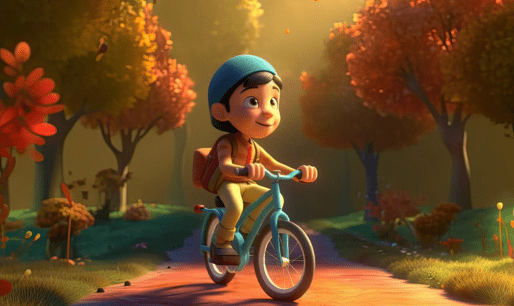Have you ever thought about why and how the best Animation company Industry came to India? What is the role of Indian Animation in the Global Marketplace?
Indian Animation Industry is now well-settled in the marketplace and now we can say that it is one of the best in dominant industry in the World.
In the kaleidoscopic realm of the global animation industry, India emerges as a vibrant hub, contributing significantly to the ever-evolving landscape of animated content. With a rich cultural tapestry and a burgeoning talent pool, Indian animation has carved a niche. This article explores the multifaceted role of Indian animation in the industry, delving into the realms of 3D animation, 2D animation, and various other forms of this captivating art form.
The Ascent of Indian Movement: A Verifiable Viewpoint
To understand the ongoing situation, following the foundations of Indian animation is fundamental. The business has made some amazing progress since its beginning, beating difficulties and embracing advancement. Early trailblazers laid the preparation, and today, India remains a force to be reckoned with in the worldwide movement field.
The Apex of Authenticity: 3D Animation in India
3D animation has turned into a main impetus in the diversion and gaming areas. India has embraced as well as succeeded in this unique field. Studios in India are making outwardly staggering and progressed 3D-energized content, procuring praise and acknowledgment around the world.
a. Bollywood Embraces 3D Animation:
The integration of 3D animation in Bollywood films has been a game-changer. From spectacular visual effects to lifelike character animations, Indian filmmakers are leveraging 3D technology to enhance storytelling and captivate audiences.
b. Global Collaborations and Outsourcing:
Indian animation studios have become sought-after partners for international collaborations and outsourcing. With a cost-effective workforce and a high level of proficiency, India has become a go-to destination for global animation projects.
The Enduring Charm of 2D Animation
While 3D animation has taken the spotlight, the charm of 2D animation remains timeless. India’s animation industry continues to produce captivating 2D content that resonates with audiences across age groups.
a. Television and 2D Animation:
Indian television has been a breeding ground for 2D animation. Iconic shows like “Mickey Mouse” and “Tom and Jerry” have been dubbed into regional languages, creating a cultural bridge and fostering a love for animation from a young age.
b. Educational Animation:
2D animation has also found a niche in educational content. Engaging and informative animations are being used to simplify complex concepts, making learning a visually stimulating experience.
Diversity in Animation: Exploring Other Forms
Beyond the realms of 3D and 2D animation, India boasts a diverse array of animation forms that contribute to its rich tapestry.
a. Stop Motion Animation:
Stop-motion animation, characterized by its frame-by-frame manipulation of physical objects, has found a place in Indian cinema and advertising. This unique form adds a tactile and authentic feel to storytelling.
b. Clay Animation:
Clay animation, popularized by films like “Wallace and Gromit,” has also made its mark in India. Studios experiment with claymation, infusing a playful and imaginative element into their creations.
Challenges and Innovations: Navigating the Animation Landscape
Despite its success, the Indian animation industry faces challenges that necessitate constant innovation. From limited budgets to competition from global players, studios in India are pushing boundaries to stay ahead.
a. Skill Development Initiatives:
Recognizing the importance of skilled animators, several initiatives and institutions have emerged to nurture talent. Training programs and workshops aim to bridge the skill gap and equip aspiring animators with the tools needed to excel in the industry.
b. Technological Advancements:
Embracing technological advancements is crucial for staying relevant. Indian studios invest in cutting-edge technologies, ensuring that their work meets global standards and pushes the boundaries of creativity.
The Global Impact: Indian Animation Beyond Borders
Indian animation’s influence extends far beyond its geographical boundaries. As more Indian animated content gains international acclaim, the industry is becoming a global player, contributing to the diversity and richness of the global animation landscape.
a. Film Festivals and Awards:
Indian animated films and shorts are making waves at international film festivals, earning accolades and recognition. This exposure not only brings prestige to Indian animation but also opens doors to collaboration and distribution on a global scale.
b. Cultural Representation:
Indian animation serves as a window into the country’s diverse culture and traditions. By incorporating authentic elements into their creations, Indian animators are entertaining and educating global audiences about the richness of Indian heritage.
Conclusion: Nurturing Creativity, Inspiring Innovation
In conclusion, the role of Indian animation in the global industry is multifaceted and ever-evolving. From the glitzy world of 3D animation to the timeless charm of 2D, and the experimentation with various forms, India’s animation industry continues to captivate audiences worldwide. As challenges are met with innovation, and talent is nurtured through education and training, the future holds immense promise for Indian animation. The global stage awaits, and Indian animators are poised to leave an indelible mark on the canvas of animation history.
Frequently Asked Questions
What makes Indian animation unique in the global industry?
Indian animation is unique due to its rich cultural influences, diverse storytelling traditions, and a fusion of traditional and modern artistic elements. This blend gives Indian animation a distinct flavor that resonates with audiences worldwide.
How has 3D animation impacted the Indian film industry, especially Bollywood?
3D animation has revolutionized the Indian film industry, enhancing visual effects and storytelling. Bollywood filmmakers are increasingly incorporating 3D animation to create visually stunning and immersive cinematic experiences.
Is 2D animation still relevant in the era of 3D animation dominance?
Absolutely. 2D animation retains its timeless charm and is widely used in Indian television, educational content, and even feature films. Its simplicity, nostalgia factor, and ability to convey emotions make it a crucial and relevant aspect of the animation industry.
What initiatives are in place to address the skill gap in the Indian animation industry?
Several initiatives and educational institutions in India focus on skill development for aspiring animators. Training programs, workshops, and collaborations with industry professionals aim to equip individuals with the skills needed to excel in the competitive animation landscape.
How does Indian animation contribute to global collaborations and outsourcing?
Indian animation studios have become preferred partners for global collaborations and outsourcing due to a skilled workforce and cost-effective production. Many international projects leverage Indian talent for animation, visual effects, and post-production work.







